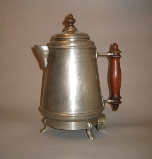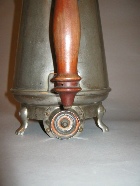




Electric Kettles



A chronology of the development of the electric kettle and related information 1886 – 1900
- 1831 Michael Faraday demonstrates the principles of electro-
magnetic current generation
- 1847 The Siemens & Halske Telegraph Construction Company is founded in Berlin with an agency in the UK.
http://w4.siemens.de/archiv/en/geschichte/zeitleiste/chronik_1.html
- 1878/79 Joseph Swan and Thomas Edison separately, demonstrate the first electric light bulb
The Story of Electricity by John Munro Pub.1902
- 1878 Crompton & Co. Ltd a pioneering UK Electrical Engineering firm is founded.
Dynamo & Motor Attendants by Frank Broadbent 10th Edition Pub. 1921
- c.1880 G. Binswanger and Co. Electrical Goods Wholesaler is established (The forerunner of the General Electric Company (G.E.C.) of Great Britain).
http://www.marconi.com/Home/about_us/Our%20History/GEC%20Heritage
- 1881 Europe’s first public supply of electricity is set up in Godalming, Surrey, England. Siemen’s Generators and arc lamps and Swan’s electric globe lights are used.
http://www.godalming-
- 1882 Edison and Swan join forces and the Edison and Swan United Electric Light Company “Ediswan”, the forerunner of the American company General Electric, is founded. Manufacturing plant is set up in both the UK and America.
- 1886 Hugo Hirst joins Gustav Byng (formerly G. Binswanger) and “The General Electric Apparatus Co.” is founded in the UK.
http://www.marconi.com/Home/about_us/Our%20History/GEC%20Heritage
- c.1886 Mr Lane-
Fox’s Electric egg/water boiler is mentioned in Mr Munro’s early book.
(Electricity & it’s uses, J. Munro 1887 pp183)
- 1887 Ferranti’s, induction current, water heater 15th January 1887 patent No.700. Declared as the first patent for this type of heating, by David Cook.
(Electrical Review June30th 1893 Vol. XXXII pp777)
- 1889 An electric lamp is used to heat water, referred to in a letter.
(Electrical Review Vol XXXII June 9th 1893 pp704)
- 1889 The General Electric Apparatus Co. changes it’s name to The General Electric Company Ltd., “G.E.C.”
- 1890 Albert Gay & Robert Hammond’s, induction heater, described as a “saucepan to contain liquid to be heated”. Patent No. 4993 31st March 1890. “Numerous appliances made…...and experimented with at the works of the Brighton & Hove Electric Light Company”.
(Electrical Review Vol. XXXII June 23rd 1893 pp760)
- 1890 Rankin Kennedy patent similar to above. Patent No. 9,956-
1890
(Electrical Review Vol. XXXII. June 23rd 1893. pp 711, 760, 777)
- c.1890 Morford Patent (USA) for electro heating machine using enamel insulation.
(The Electrical Review (USA) Vol.24 May 1894 pp246)
- 1890 March. GEC sell an electric kettle in London.
(The Electrical Review vol. LXXI December 6th 1912 pp910)
- 1890 The Edison General Electric Co. Is formed in the USA.
http://www.ge.com/en/company/companyinfo/at_a_glance/history_story.htm
- 1891 24th February Carpenter Electric Heating Co. USA awarded a patent (441 US Patents with this patent date and no quick way of searching them so, patent not yet found)
- 1891 c.August; Carpenter Electric Heating Co. St Pauls, Minnesota, USA. Manufacture a kettle with resistance wire enamelled to the base
(The Electrical Engineer (USA) 12th October 1892 pp359
& Shell Book of Firsts pp 231)
- 1891 Carpenter Electric Heating Co. Tea Pot
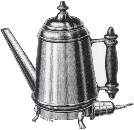
Tea Pot from Walter & Kepler catalogue 1893
This information kindly provided by Patrick Sheary
- 1891 Carpenter Electric Heating Co. Coffee Pot
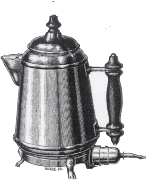
These images and information kindly provided by Patrick Sheary
- 1892 6th January. Patent No. 259, granted to Arnold Beaumont Woakes for heating water by immersed electrodes.
(Refered to in Patent No. GB189311749 “Improvements in heating liquids by electricity” granted to Mr Woakes 5th May 1894.)
- 1892 9th January. Electrical exhibition opens at the Crystal Palace to celebrate a decade of electrical engineering
(http://www.lexicon.net/fiawol/crystal.htm)
- 1892 Crompton & Co. exhibit a working kettle using resistance wire enamelled to the base, demonstrated by Mr. Dowsing
(Electricity 25th March 1892 pp247)
- 1892 The Carpenter Kettle is exhibited at the Crystal Palace Exhibition.
(The Electrical Engineer (UK) 15th April 1892. pp362 )
- 1892 Carpenter kettle
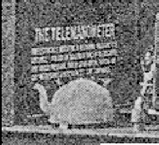
(The Electrical Engineer (USA) June 24th 1892 pp612)
(Although reproduced here, it seems likely that this kettle was designed to be used on top of an electric “disk heater” or hotplate and isn’t therefore an electric kettle)
- 1892 W. J. Hammer claims enamelled resistance wire heaters are the invention of Mr. Carpenter
(The Electrical Engineer 15th April 1892 pp362)
- 1892 Mr Hammer exhibits an imported Carpenter kettle; Messrs Crompton & Co. exhibit a kettle with Resistance wire enamelled to the base of the kettle; Binswanger & Hirst (GEC) exhibit a kettle with the wires cemented to the base.
(The Electrical Review 26th May 1893 pp617: The Electrical Review 2nd June 1893 pp670)
- 1892 2nd July Electrical exhibition at Crystal Palace closes
(http://www.lexicon.net/fiawol/crystal.htm)
- 1892 Messrs. Crompton continue to demonstrate their kettle, without any apparent litigation for patent infringement from the Carpenter company.
(The Electrical Review 23rd September 1892 pp384)
- 1892 Many American firms are engaged in the manufacture of “electric utensils” claims an article.
(Electricity (USA) 21st December 1892)
- 1892 Miller & Woods Lamp kettle is manufactured by Edison & Swan United Co. (UK branch)
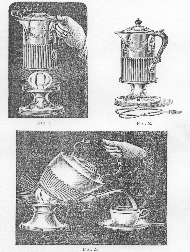 (Patent 23,321 19th Dec 1892. The Electrical Review Vol. XXXII. June 2nd 1893 pp670: and June 30th 1893 pp792. The Electrical Review Vol. XXXIII July 28th 1893 pp97)
(Patent 23,321 19th Dec 1892. The Electrical Review Vol. XXXII. June 2nd 1893 pp670: and June 30th 1893 pp792. The Electrical Review Vol. XXXIII July 28th 1893 pp97)
- 1892 The Edison General Electric Company in America is merged with the Thomson – Houston Co. to form the “General Electric Co.” (GE)
- 1893 Two levels of development take place: The first asbestos-
covered wire resistance coil appliances described as “deficient in the most elementary design (and akin to the toddy ladle)”. Second, Carpenter in the states and Crompton in England bury Iron resistance wires in enamel and at about the same time Binswanger and Hirst used Platino- Iridium wire in vitreous cement. These kettles took approximately 20 minutes to boil 1pt water.
(The Electrical Review May 26th 1893 pp 617 (and reprinted in)
Electricity (USA) Vol.4 No.22, June 14th 1893 pp300)
- 1893 Carpenter Tea Kettle
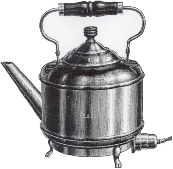
Walter & Kepler catalogue 1893.
Agents for Carpenter Electric Heating MNFG. Co.
Philadelphia, USA)
This information kindly provided by Patrick Sheary
- 1893 “Messrs. Crompton may be fairly credited with the first practically successful attempt to utilise electricity for domestic heating purposes”.
(Electrical Review Vol. XXXII June 2nd 1893 pp669)
- 1893 Arnold Beaumont Woakes requests a patent for an improved immersed electrode water heater.
 (Patent granted GB189311749 5th May 1894)
(Patent granted GB189311749 5th May 1894)
- 1893 Zipernowski’s carbon arc kettle is refered to
(Electrical Review Vol. XXXII June 16th 1893 pp711)
- 1893 GEC tea-
kettle (12 minutes to boil 1pt. & sectional view
and cost about £1.10.00)

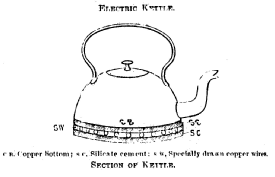
(SB, Copper Bottom; SC, Silicate Cement; SW, Specially drawn copper wire.)
(Electrical Review Sept 29 1893 pp350)
- 1893 GEC Coffee Pot & Stew Pan
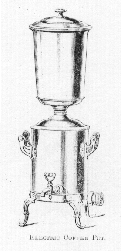
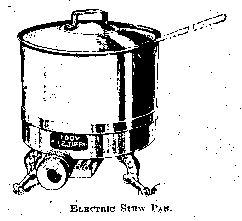
(The Electrical Review Vol XXXIII Sept 29th 1893 pp350/351)
- 1894 William Corin’s portable water heater. Resistance wire element wound in void between two containers.
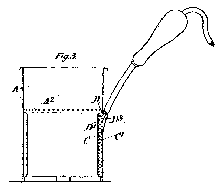 (Patent 7,933 21st April 1894)
(Patent 7,933 21st April 1894)
- 1894 Carpenter’s patent for electro heating machine by enamel insulation is “set aside” in the American courts as Morford was the prior inventor in 1890. This decision is subsequently reversed.
(The Electrical Review (USA) Vol.24 May 1894. pp246)
- 1894 Crompton-
Dowsing’s Parlour tea kettle
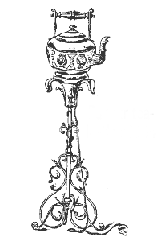 (Electric light installations, vol. 2. Sir David Salomons. 1894. pp301.)
(Electric light installations, vol. 2. Sir David Salomons. 1894. pp301.)
- 1894 Crompton-
Dowsing’s Bronchitis kettle
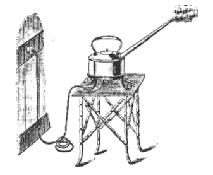 (Electric light installations vol 2 pp303 Sir David Salomons 1894)
(Electric light installations vol 2 pp303 Sir David Salomons 1894)
- 1894 Presumed to be a Crompton-
Dowsing tea kettle (for similarity of feet to above picture)
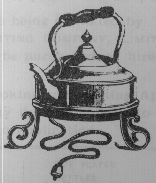
“Cooking by Electricity” The City of London Electric Lighting Co. Ltd. Promotional Leaflet (pub July 1894)
- 1894 Mappin & Webb silver-
plated hot- water jug and tea- kettle, made under license after the Miller & Woods patent of 1892. Available with 8, 16 and 50 candle power lamps, the 50cp lamp will boil the full 2.5 pints of water in 25 minutes; the 16cp lamp will keep the water at boiling point whilst the 8cp lamp “will keep the boiling water sufficiently hot for afternoon tea.”


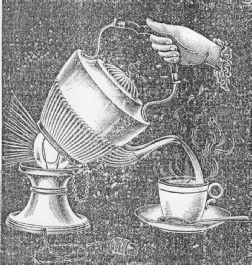
“The Electrician” 2nd November 1894
- 1895 Octavius March. The first immersed enclosed element, as opposed to immersed electrode, water heater
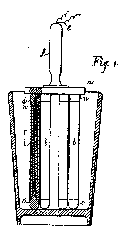 (Patent 13,444 12th July 1895)
(Patent 13,444 12th July 1895)
- 1896 Emile Placet of Paris invents Nickel-
chromium alloy.
Patent GB 1896202
- 1897 Schindler-
Jenny’s Patent GB189729821 granted. Describing the casting of heating wires into a solid metal housing.
- 1898 Presumed to be a Crompton bronchitis kettle (based on under base connector see c1900 Crompton catalogue)
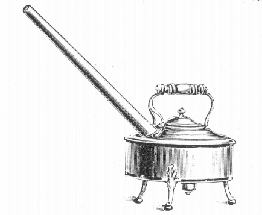 (“Electricity in Town & Country Houses”, Percy E Scrutton, Pub.1898. pp128;)
(“Electricity in Town & Country Houses”, Percy E Scrutton, Pub.1898. pp128;)
- 1898 Simplex Conduit Company formed, later renamed Credenda and then Creda
- 1899 Simplex Kettles
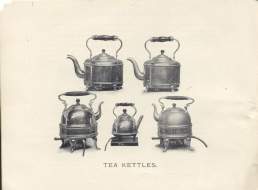
Simplex USA catalogue
This information kindly provided by Patrick Sheary
- 1899 First practical boil-
dry protector is patented (subsequently used by Messrs Isenthal)
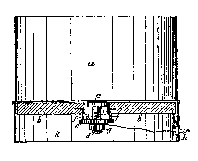 (Friedrich Wilhelm Schindler. Patent No. 10,839 24th May 1899)
(Friedrich Wilhelm Schindler. Patent No. 10,839 24th May 1899)
- 1900 Alexander Ritchie Leask patents his Immersed Heating element
 (Patent No9263 19thMay1900, pub.06-
(Patent No9263 19thMay1900, pub.06-
- 1900 Crompton tea kettle
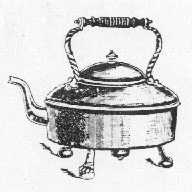 (”R.E.B. Crompton Pioneer Electrical Engineer”. Brian Bowers. “Reproduced from Crompton catalogue c1900”)
(”R.E.B. Crompton Pioneer Electrical Engineer”. Brian Bowers. “Reproduced from Crompton catalogue c1900”)
- c1900 GEC tea kettle similar shaped spout and feet to 1893 model (unfortunately no lid).
R. Saunders (private collection.)
Prior to 1880 a mere handful of people had even heard of “Electricity” let alone had any experience of it. Yet in a little over 20 years most people in the larger Cities and Towns had seen the effects of electric lighting in the theatre, on the roadside or in shops and hotels. A few intrepid people, lucky enough to live near the “electric main”, or rich enough to own a generator and battery set, had even had it installed in their own homes.
Electric kettles began as play things of the rich, a means to impress your guests with your modernity. It didn’t matter that they cost many times a labourers weekly wage or that they had a very limited life expectancy and were irreparable and that’s not to mention the running costs.
Yet by 1900 the electric kettle had already assumed it’s well known shapes and many people were, by now, engaged on the thorny problems of boil-
Very few kettles made before 1900 now exist.
Illustrations in printed material exist mainly as wood blocks showing “artists impressions”.
Certainly most patented designs never made it into manufacture yet this remains the source of our most accurate descriptions of early kettles.
Period catalogues contain photographs of early designs.


